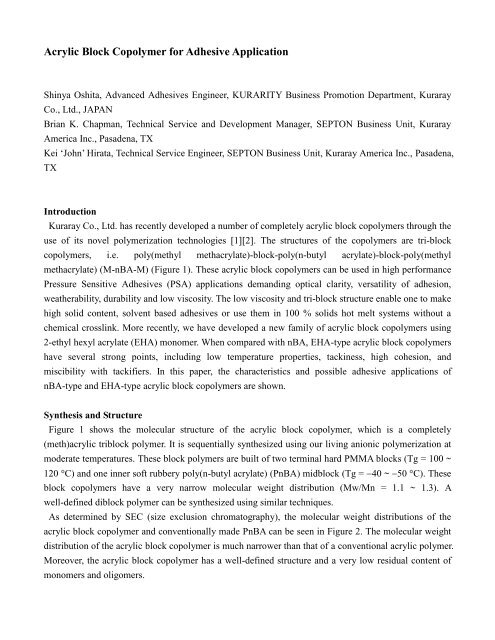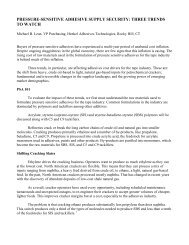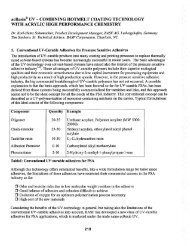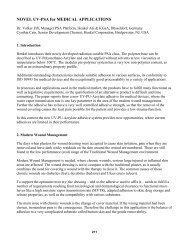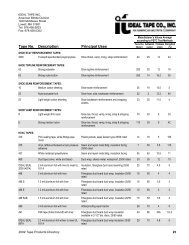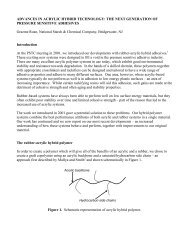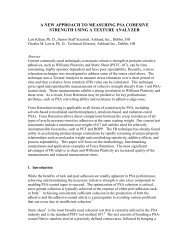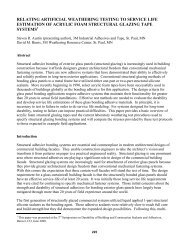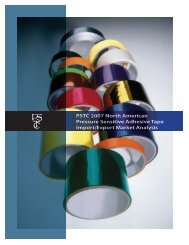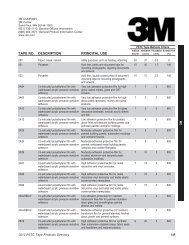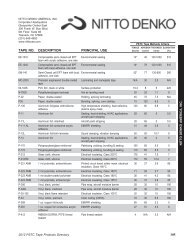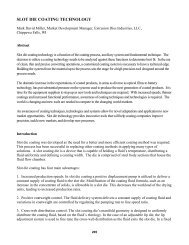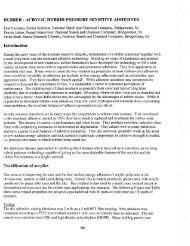Acrylic Block Copolymer for Adhesive Application - PSTC. Pressure ...
Acrylic Block Copolymer for Adhesive Application - PSTC. Pressure ...
Acrylic Block Copolymer for Adhesive Application - PSTC. Pressure ...
Create successful ePaper yourself
Turn your PDF publications into a flip-book with our unique Google optimized e-Paper software.
<strong>Acrylic</strong> <strong>Block</strong> <strong>Copolymer</strong> <strong>for</strong> <strong>Adhesive</strong> <strong>Application</strong>Shinya Oshita, Advanced <strong>Adhesive</strong>s Engineer, KURARITY Business Promotion Department, KurarayCo., Ltd., JAPANBrian K. Chapman, Technical Service and Development Manager, SEPTON Business Unit, KurarayAmerica Inc., Pasadena, TXKei „John‟ Hirata, Technical Service Engineer, SEPTON Business Unit, Kuraray America Inc., Pasadena,TXIntroductionKuraray Co., Ltd. has recently developed a number of completely acrylic block copolymers through theuse of its novel polymerization technologies [1][2]. The structures of the copolymers are tri-blockcopolymers, i.e. poly(methyl methacrylate)-block-poly(n-butyl acrylate)-block-poly(methylmethacrylate) (M-nBA-M) (Figure 1). These acrylic block copolymers can be used in high per<strong>for</strong>mance<strong>Pressure</strong> Sensitive <strong>Adhesive</strong>s (PSA) applications demanding optical clarity, versatility of adhesion,weatherability, durability and low viscosity. The low viscosity and tri-block structure enable one to makehigh solid content, solvent based adhesives or use them in 100 % solids hot melt systems without achemical crosslink. More recently, we have developed a new family of acrylic block copolymers using2-ethyl hexyl acrylate (EHA) monomer. When compared with nBA, EHA-type acrylic block copolymershave several strong points, including low temperature properties, tackiness, high cohesion, andmiscibility with tackifiers. In this paper, the characteristics and possible adhesive applications ofnBA-type and EHA-type acrylic block copolymers are shown.Synthesis and StructureFigure 1 shows the molecular structure of the acrylic block copolymer, which is a completely(meth)acrylic triblock polymer. It is sequentially synthesized using our living anionic polymerization atmoderate temperatures. These block polymers are built of two terminal hard PMMA blocks (Tg = 100 ~120 C) and one inner soft rubbery poly(n-butyl acrylate) (PnBA) midblock (Tg = 40 ~ 50 C). Theseblock copolymers have a very narrow molecular weight distribution (Mw/Mn = 1.1 ~ 1.3). Awell-defined diblock polymer can be synthesized using similar techniques.As determined by SEC (size exclusion chromatography), the molecular weight distributions of theacrylic block copolymer and conventionally made PnBA can be seen in Figure 2. The molecular weightdistribution of the acrylic block copolymer is much narrower than that of a conventional acrylic polymer.Moreover, the acrylic block copolymer has a well-defined structure and a very low residual content ofmonomers and oligomers.
G '[P a]G’ (Pa)(a) (b) (c)Figure 3. Morphology of acrylic block copolymers by TEM. (a) Short cylindrical morphology <strong>for</strong>M-nBA-M 1 (low PMMA content), (b) Long cylindrical morphology <strong>for</strong> M-nBA-M 2 (mid PMMAcontent.), and (c) Lamellar morphology <strong>for</strong> M-nBA-M 3 (high PMMA content).RheologyDynamic mechanical analysis (DMA) of the acrylic block copolymers indicate the elastic modulus ofthe different molecular structures (Figure 4). These materials can be used in a variety of applicationsincluding injection molded materials, films, resin modifiers and pressure sensitive adhesives, i.e. PSA.The elastic modulus range is very suitable <strong>for</strong> PSA applications since tackifiers and plasticizers are notessential <strong>for</strong> PSA <strong>for</strong>mulations.1.E+091.E+0810 81.E+0710 71.E+0610 610 9 (a)1.E+0510 51.E+0410 4(b)(c)1.E+0310 31.E+0210 2-50 0 50 100 150 200-50 50 100 150 200Temperature T EM P [℃]( C)Figure 4. DMA curves of acrylic block copolymers. (a) M-nBA-M 2 (mid PMMA content), (b)M-nBA-M 1 (low PMMA content), and (c) M-nBA-M 1 / M-nBA = 50wt%/50wt%. M-nBA is the verylow PMMA content diblock polymer which is in liquid <strong>for</strong>m.
tanMiscibility of <strong>Acrylic</strong> <strong>Block</strong> <strong>Copolymer</strong>s and TackifiersIn designing a PSA <strong>for</strong>mulation with acrylic block copolymers, the miscibility with tackifiers needs tobe considered. In principle, tackifiers and plasticizers should be selectively compatible with the PnBAblock domain. Miscibility data of acrylic block copolymer/tackifier systems are shown in Figure 5 viatan delta curves. With increasing tackifier content, the glass transistion temperature, Tg, of the PnBAblock shifts to a higher temperature. This indicates that the PnBA block and tackifier are miscible. Inhigh tackifier content <strong>for</strong>mulations, it is noted that the PnBA domain becomes saturated and the tackifierbecomes free. (Figure 5(c))101(a)(b)(c)0.10.01-150 -100 -50 0 50 100 150 200Temperature ( C)Figure 5. Effect of tackifier content on the loss tangent (tan δ) of acrylic block polymer / tackifiersystems. M-nBA-M 1 / tackifier = (a)100/0, (b)100/30, and (c)100/100. Tackifier is a hydrogenatedrosin ester type.<strong>Block</strong> <strong>Copolymer</strong>s Using Long-Chain Alkyl Acrylate as the Soft <strong>Block</strong>EHA is a popular monomer in conventional crosslinked acrylic PSAs. Similarly, to nBA, EHA can beutilized in the living anionic polymerization system. DMA curve of M-EHA-M indicates micro phaseseparation is sharp as well as M-nBA-M (Figure 6).Figure 6 also indicates the Tg shifts to lower temperatures with an increase in EHA ratio of the softblock. This should give rise to an improvement of low temperature properties. And, the cohesion ofEHA type is superior to that of the nBA-type. This is confirmed by a creep test and SAFT (shearadhesion failure temperature) test. Additional benefits of EHA-type block copolymers were confirmedincluding improved tackiness and miscibility with tackifiers.
Peel Adhesion (N/25mm)接 着 力 [N /25m m ]@25℃ 対 S U S2520151050M-nBA-M 1 / M-nBA=100/200M-nBA-M 1 / M-nBA=100/100With TackifierOnly acrylic block copolymerM-nBA-M 1M-nBA-M 20 5 10 15 20 25 30 35 40MMA MMA Content 含 量 [ in 重 PSA 量 %](wt%)Figure 7. Adhesion strength of acrylic block copolymer and tackifier <strong>for</strong>mulations. (thickness =25 m,180 peel strength, peel speed =300mm/min)Table 1. PSA Formulations and PropertiesFormulation1 2 3 4 CE1 CE2M-nBA-M (low PMMA cont.) 100 100 100 100M-nBA (low PMMA cont. in liquid <strong>for</strong>m) 0 20 0 0Tackifier A (Rosin Ester) 35 35 35 0Tackifier B (Aromatic Resin) 0 0 0 35Plasticizer (<strong>Acrylic</strong> oligomer) 0 0 20 20Hot MeltRubber<strong>Adhesive</strong>Doublesidedacrylic tapewithnon-wovenfabric basefilmCoating Thickness ( m) 53 58 64 62 35 165Rolling Ball Tack Test * 7 8 11 7


